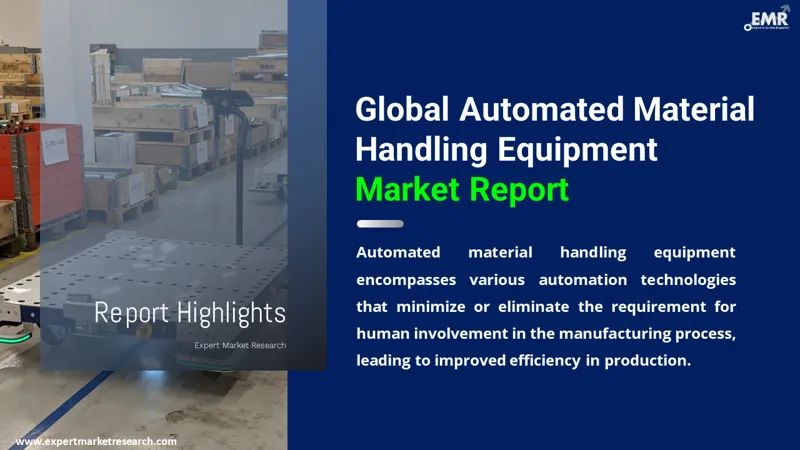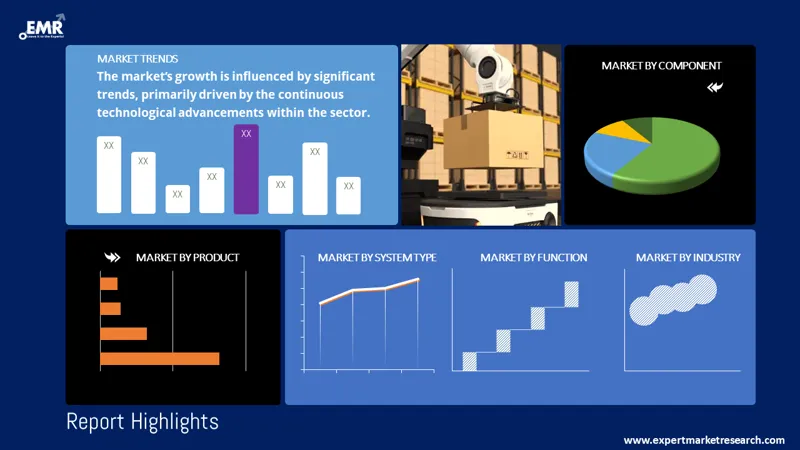
Consumer Insights
Uncover trends and behaviors shaping consumer choices today
Procurement Insights
Optimize your sourcing strategy with key market data
Industry Stats
Stay ahead with the latest trends and market analysis.
The global automated material handling equipment market size reached approximately USD 49.09 Billion in 2025. The market is assessed to grow at a CAGR of 8.50% between 2026 and 2035 to attain a value of around USD 110.99 Billion by 2035.
Base Year
Historical Period
Forecast Period
Compound Annual Growth Rate
8.5%
Value in USD Billion
2026-2035
*this image is indicative*
Automated material handling equipment refers to automation solutions that reduce or eliminate the need for human intervention throughout the product manufacturing process, offering enhanced efficiency during production. It includes the use of various robots and automated devices for the movement, storage, and control of different materials used in facilities.

Read more about this report - REQUEST FREE SAMPLE COPY IN PDF
The Expert Market Research's report titled “Automated Material Handling Equipment Market Report and Forecast 2026-2035” offers a detailed analysis of the market based on the following segments:
Market Breakup by Component
Market Breakup by Product
Market Breakup by System Type
Market Breakup by End Use
Market Breakup by Region

Read more about this report - REQUEST FREE SAMPLE COPY IN PDF
As per the automated material handling equipment market analysis, the automotive sector extensively deploys automated solutions and computerised devices, including robots/robotic arms, to ensure optimal movement of heavy parts across the assembly line and eliminate the requirement for manually moving and lifting different components.
Automated material handling solutions also improve employee safety, reduce maintenance costs, and enhance automotive manufacturers' efficiency, uptime, and return on investment (ROI). Meanwhile, in the food and beverage sector, growing attempts to optimise different processes, improve sanitation, and ensure accurate packaging are likely to boost the usage of material handling equipment in the forecast period.
North America represents a significant portion of the automated material handling equipment market share due to the growing adoption of automation technologies in the region. The introduction of stringent government regulations aimed at ensuring the safety of workers in workplaces is also fuelling the adoption of material handling automation solutions in North America.
The Asia Pacific automated material handling equipment market is also growing due to factors like rapid industrialisation and the increasing adoption of advanced technologies by manufacturers. There is also a surging demand for different types of material handling systems in flourishing end-use sectors like automotive, e-commerce, healthcare, and food and beverages.
The report gives a detailed analysis of the following key players in the global automated material handling equipment market, covering their competitive landscape and latest developments like mergers, acquisitions, investments and expansion plans.
established in 1937, is a pioneer in the automated material handling system market. Its systems combine storage, conveying, control, sorting, and picking to serve diverse sectors such as manufacturing and automotive. Headquartered in Osaka, Japan, the company uses innovative technologies to meet the diverse requirements of its customers.
is a leading intralogistics company that is based in Hamburg, Germany. The company has established its position as a pioneer in the material handling sector and aims to develop warehouses of the future through its innovative solutions. The company is committed to all areas of intralogistics, ranging from industrial trucks to automated intralogistics solutions.
is a prominent intralogistics solution provider and one of the largest suppliers of material handling systems and automated storage systems. It also maintains, develops, and produces dynamic retrieval and storage systems and automated high-bay warehouses. With its presence in nearly 30 countries, the company is listed on the Swiss SIX Stock Exchange.
*Please note that this is only a partial list; the complete list of key players is available in the full report. Additionally, the list of key players can be customized to better suit your needs.*
Other automated material handling equipment manufacturers include KION GROUP AG, SSI SCHAEFER Group, Honeywell International Inc, KNAPP AG, Mecalux, S.A., Siemens AG, KUKA AG, Toyota Industries Corp., BEUMER Group GmbH & Co. KG, Krones AG (System Logistics S.p.A.), Interroll Holding AG, TGW Logistics Group, and viastore SYSTEMS GmbH.




*While we strive to always give you current and accurate information, the numbers depicted on the website are indicative and may differ from the actual numbers in the main report. At Expert Market Research, we aim to bring you the latest insights and trends in the market. Using our analyses and forecasts, stakeholders can understand the market dynamics, navigate challenges, and capitalize on opportunities to make data-driven strategic decisions.*
Get in touch with us for a customized solution tailored to your unique requirements and save upto 35%!
In 2025, the market attained a value of nearly USD 49.09 Billion.
The market is assessed to grow at a CAGR of 8.50% between 2026 and 2035.
The market is estimated to witness a healthy growth in the forecast period of 2026-2035 to reach about USD 110.99 Billion by 2035.
The major market drivers are rapid industrialisation and the advent of Industry 4.0.
The key trends aiding the market growth are the increasing adoption of advanced technologies by businesses, the increasing development of smart factories with reduced wastage and enhanced operational effectiveness, and the advent of 5G technology.
The major regions in the market are North America, Latin America, the Middle East and Africa, Europe, and the Asia Pacific.
Software, hardware, and services are the various components of automated material handling equipment.
The different end uses of automated material handling equipment are automotive, semiconductors and electronics, food and beverages, chemicals, pharmaceuticals, and aviation, among others.
The several products considered in the market report are robots, automated storage and retrieval systems (ASRS), conveyor and sortation systems, cranes, and automated guided vehicles (AGV).
The significant system types of automated material handling equipment are unit load material handling systems and bulk load material handling systems.
The major players in the market are Daifuku Co., Ltd., Jungheinrich AG, Kardex Holding AG, KION GROUP AG, SSI SCHAEFER Group, Honeywell International Inc, KNAPP AG, Mecalux, S.A., Siemens AG, KUKA AG, Toyota Industries Corp., BEUMER Group GmbH & Co. KG, Krones AG (System Logistics S.p.A.), Interroll Holding AG, TGW Logistics Group, and viastore SYSTEMS GmbH, among others.
Explore our key highlights of the report and gain a concise overview of key findings, trends, and actionable insights that will empower your strategic decisions.
| REPORT FEATURES | DETAILS |
| Base Year | 2025 |
| Historical Period | 2019-2025 |
| Forecast Period | 2026-2035 |
| Scope of the Report |
Historical and Forecast Trends, Industry Drivers and Constraints, Historical and Forecast Market Analysis by Segment:
|
| Breakup by Component |
|
| Breakup by Product |
|
| Breakup by System Type |
|
| Breakup by End Use |
|
| Breakup by Region |
|
| Market Dynamics |
|
| Competitive Landscape |
|
| Companies Covered |
|
Datasheet
One User
USD 2,499
USD 2,249
tax inclusive*
Single User License
One User
USD 3,999
USD 3,599
tax inclusive*
Five User License
Five User
USD 4,999
USD 4,249
tax inclusive*
Corporate License
Unlimited Users
USD 5,999
USD 5,099
tax inclusive*
*Please note that the prices mentioned below are starting prices for each bundle type. Kindly contact our team for further details.*
Flash Bundle
Small Business Bundle
Growth Bundle
Enterprise Bundle
*Please note that the prices mentioned below are starting prices for each bundle type. Kindly contact our team for further details.*
Flash Bundle
Number of Reports: 3
20%
tax inclusive*
Small Business Bundle
Number of Reports: 5
25%
tax inclusive*
Growth Bundle
Number of Reports: 8
30%
tax inclusive*
Enterprise Bundle
Number of Reports: 10
35%
tax inclusive*
How To Order

Select License Type
Choose the right license for your needs and access rights.

Click on ‘Buy Now’
Add the report to your cart with one click and proceed to register.

Select Mode of Payment
Choose a payment option for a secure checkout. You will be redirected accordingly.
Gain insights to stay ahead and seize opportunities.

Get insights & trends for a competitive edge.

Track prices with detailed trend reports.

Analyse trade data for supply chain insights.

Leverage cost reports for smart savings

Enhance supply chain with partnerships.

Connect For More Information
Our expert team of analysts will offer full support and resolve any queries regarding the report, before and after the purchase.
Our expert team of analysts will offer full support and resolve any queries regarding the report, before and after the purchase.
We employ meticulous research methods, blending advanced analytics and expert insights to deliver accurate, actionable industry intelligence, staying ahead of competitors.
Our skilled analysts offer unparalleled competitive advantage with detailed insights on current and emerging markets, ensuring your strategic edge.
We offer an in-depth yet simplified presentation of industry insights and analysis to meet your specific requirements effectively.
Share